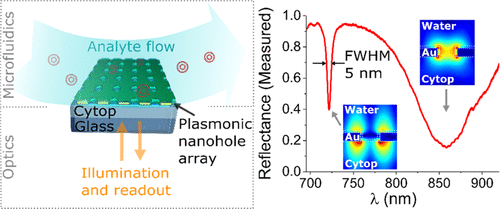Our official English website, www.x-mol.net, welcomes your
feedback! (Note: you will need to create a separate account there.)
Plasmonic Sensing on Symmetric Nanohole Arrays Supporting High-Q Hybrid Modes and Reflection Geometry.
ACS Sensors ( IF 8.2 ) Pub Date : 2019-12-09 , DOI: 10.1021/acssensors.9b01780 Milan Vala 1, 2 , Christopher T Ertsgaard 1 , Nathan J Wittenberg 1, 3 , Sang-Hyun Oh 1
ACS Sensors ( IF 8.2 ) Pub Date : 2019-12-09 , DOI: 10.1021/acssensors.9b01780 Milan Vala 1, 2 , Christopher T Ertsgaard 1 , Nathan J Wittenberg 1, 3 , Sang-Hyun Oh 1
Affiliation

|
Refractometric sensors utilizing surface plasmon resonance (SPR) should satisfy a series of performance metrics, bulk sensitivity, thin-film sensitivity, refractive-index resolution, and high-Q-factor resonance, as well as practical requirements such as manufacturability and the ability to separate optical and fluidic paths via reflection-mode sensing. While many geometries such as nanohole, nanoslit, and nanoparticles have been employed, it is nontrivial to engineer nanostructures to satisfy all of the aforementioned requirements. We combine gold nanohole arrays with a water-index-matched Cytop film to demonstrate reflection-mode, high-Q-factor (Qexp = 143) symmetric plasmonic sensor architecture. Using template stripping with a Cytop film, we can replicate a large number of index-symmetric nanohole arrays, which support sharp plasmonic resonances that can be probed by light reflected from their backside with a high extinction amplitude. The reflection geometry separates the optical and microfluidic paths without sacrificing sensor performance as is the case of standard (index-asymmetric) nanohole arrays. Furthermore, plasmon hybridization caused by the array refractive-index symmetry enables dual-mode detection that allows distinction of refractive-index changes occurring at different distances from the surface, making it possible to identify SPR response from differently sized particles or to distinguish binding events near the surface from bulk index changes. Due to the unique combination of a dual-mode reflection-configuration sensing, high-Q plasmonic modes, and template-stripping nanofabrication, this platform can extend the utility of nanohole SPR for sensing applications involving biomolecules, polymers, nanovesicles, and biomembranes.
中文翻译:

支持高Q混合模式和反射几何的对称纳米孔阵列上的等离子传感。
利用表面等离子体激元共振(SPR)的折光率传感器应满足一系列性能指标,体积灵敏度,薄膜灵敏度,折射率分辨率和高Q因子共振,以及诸如可制造性和制造能力的实际要求。通过反射模式感测将光学和流体路径分开。尽管已经采用了许多几何形状,例如纳米孔,纳米狭缝和纳米颗粒,但对纳米结构进行工程设计以满足所有上述要求并非易事。我们将金纳米孔阵列与水折射率匹配的Cytop膜相结合,以展示反射模式,高Q因子(Qexp = 143)对称等离子体传感器结构。使用带有Cytop膜的模板剥离,我们可以复制大量折射率对称的纳米孔阵列,它们支持尖锐的等离子体共振,可以用从其背面反射的,具有高消光幅度的光来探测。反射几何结构将光学和微流体路径分开,而不会像标准(折射率不对称)纳米孔阵列那样牺牲传感器性能。此外,由阵列折射率对称性引起的等离激元杂交可实现双模式检测,从而可以区分在距表面不同距离处发生的折射率变化,从而有可能从不同大小的颗粒中识别SPR响应或区分附近的结合事件。体积指数的表面发生变化。由于双模式反射配置感应,高Q等离子体模式和模板剥离纳米加工的独特结合,
更新日期:2019-12-11
中文翻译:

支持高Q混合模式和反射几何的对称纳米孔阵列上的等离子传感。
利用表面等离子体激元共振(SPR)的折光率传感器应满足一系列性能指标,体积灵敏度,薄膜灵敏度,折射率分辨率和高Q因子共振,以及诸如可制造性和制造能力的实际要求。通过反射模式感测将光学和流体路径分开。尽管已经采用了许多几何形状,例如纳米孔,纳米狭缝和纳米颗粒,但对纳米结构进行工程设计以满足所有上述要求并非易事。我们将金纳米孔阵列与水折射率匹配的Cytop膜相结合,以展示反射模式,高Q因子(Qexp = 143)对称等离子体传感器结构。使用带有Cytop膜的模板剥离,我们可以复制大量折射率对称的纳米孔阵列,它们支持尖锐的等离子体共振,可以用从其背面反射的,具有高消光幅度的光来探测。反射几何结构将光学和微流体路径分开,而不会像标准(折射率不对称)纳米孔阵列那样牺牲传感器性能。此外,由阵列折射率对称性引起的等离激元杂交可实现双模式检测,从而可以区分在距表面不同距离处发生的折射率变化,从而有可能从不同大小的颗粒中识别SPR响应或区分附近的结合事件。体积指数的表面发生变化。由于双模式反射配置感应,高Q等离子体模式和模板剥离纳米加工的独特结合,











































 京公网安备 11010802027423号
京公网安备 11010802027423号